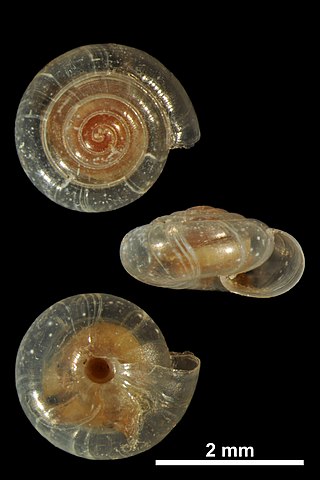Top Qs
Timeline
Chat
Perspective
Vitrea contracta
Species of gastropod From Wikipedia, the free encyclopedia
Remove ads
Vitrea contracta, the milky crystal snail, is a species of small, air-breathing land snail, a terrestrial pulmonate gastropod mollusk in the family Pristilomatidae.[1]
Remove ads
Description
Summarize
Perspective

For terms see gastropod shell.
The 2.2-2.6 mm. shell is colourless translucent and shiny. It is almost smooth with 4-5 whorls, the last whorl width seen from above 1.4-1.6 x of penultimate whorl. The umbilicus is moderately wide, becoming wider at the last whorl.

The coiled, rather small, dextral shell is strongly oblate-conical, almost disc-shaped. When mature, the shell is 1.8 to 3.0 (usually about 2 mm) wide (diameter) and 1.0 to 1.4 mm high. Viewed from its side, the seam is only slightly raised. The shell consists of 4 to 5 whorls, which increase slowly and regularly. The body whorl is relatively narrow. Seen from above, each whorl increases by about 1.4 to 1.6 times the size of the previous whorl. The top of the whorls has a flat curve, so that the seams are also very flat. The outline of the shell is well rounded, its bottom is relatively flat. The aperture has a flattened-elliptical shape in its entire circumference and is obliquely crescent-shaped because of the deep cut of the previous whorl. The outer lip is straight and tapering and not thickened . The umbilicus is deep and broad, becoming wider at the body whorl. All convolutions are visible in the navel.
The epidermis of the shell is colorless and translucent to slightly milky. The surface is very glossy. There are very fine, irregular growth lines and a suggestion of spiral lines.[2][circular reference]
Remove ads
Distribution
This species occurs in countries and islands of central and northwestern Europa including:
- Czech Republic
- Ukraine[3]
- Great Britain
- Ireland
- Iceland
- and sometimes introduced in other areas such as Palestine, California, Washingston (state) and Toronto, Ontario.
These snails live hidden in the litter, in loose soil, at the foot of rocks or among rubble, in meadows with rubble, forests with stones and rubble, but also in cool gorges and swampy alder grooves, even in holes and crevices. In protected biotopes they also remain active in winter. The species occurs in moist to dry habitats on calcareous soils.
Remove ads
References
External links
Wikiwand - on
Seamless Wikipedia browsing. On steroids.
Remove ads

